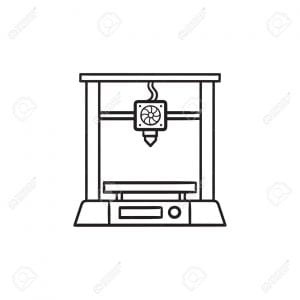Outreach Robot
Timeline
Fall 2019 – Spring 2020
Students
- Jesee Calzada
- Jeswin Mathew
- Pratikshya Devkota
- Alexander Windeler
- Sedick Iyamah
Abstract
The purpose of this project is to wow potential students of computer science/engineering with a project that will be able to be completed in the span of two semesters. Most people are interested in things of the future. A device drawing what you draw on a tablet will be used to provide that wow factor. It will make the student think if there are devices that can copy what I draw on this tablet what else is possible with technology? This system will let the potential student know if they choose to pursue engineering they too can work of technologies of the future if they decide to do so.
Background
The current devices which are capable of mimicking the human’s drawing/writing interaction into motion is currently made more as a commercial product. The devices found include smaller portable robotic arms capable of mimicking motion on paper for recreating the drawings. Our device will be better as it will be more appealing to children and can be used at a certain lab or room for entire school classrooms, rather than for individual use. Our device is more simple and accurate than products currently available. It will also be more durable and modifiable for future semesters or for other senior design teams to expand on. If other senior design teams decide to modify this project UTA could use it for the purpose of showing off to freshmen or high schoolers interested in computer science engineering. This project is highly modifiable as it uses G-code and acts as a 3d printer so in theory anything that configures the use of a 3d printer could be modified to support this device.
Project Requirements
- A software like Inkscape will be used for providing the interface to create the drawing.
- The drawing will be converted to G-code from the drawing app used on the tablet.
- The device will implement functionalities to recreate the drawing.
- The project shall use a tablet compatible with Windows 8 or above computer.
- A pen shall be used as the drawing tool for the device.
- The arm shall begin drawing no longer than 3 seconds after receiving the G-code from the computer.
- USB will be used for communicating between the device and the tablet.
- The device should have at least 70 percent accuracy when recreating a drawing from a participant not including the size of the drawing.
- A python script shall adjust the G-code to work correctly for the device and the type of pen used.
- A windows 8 or above computer shall be used to communicate with the device and the tablet.
System Overview
The process first starts with the user drawing on a tablet in Inkscape. After the figure is drawn the 2nd step is converting that drawing to G-code so the modified 3d printer will be able to move correctly based on what is drawn. The 3rd step is to modify that G-code with a python script in order to eliminate unnecessary G-code and to insert G-code that adjusts the height of writing utensil. Finally the last and final step is to send the modified G-code to the printer and watch as a machine duplicates the drawing that was provided by the participant.
Future Work
Possible improvements to this project include the ability to use multiple colors and the real time copying of the users drawing. Also the possibility of moving the system from a 3d printer over to a robotic arm that can accept G-code as input.
Project Files
System_requirements_specification
detailed_design_specification_latex
References
N/A
